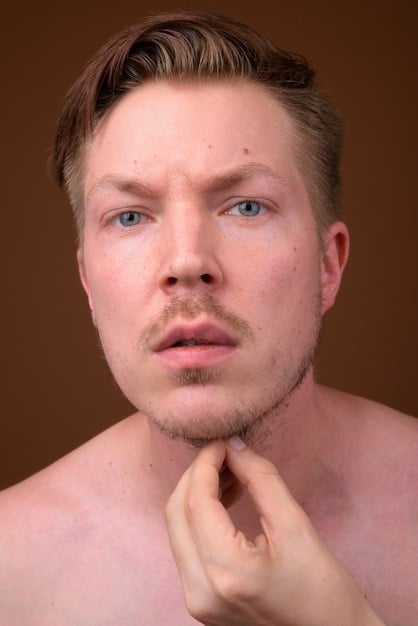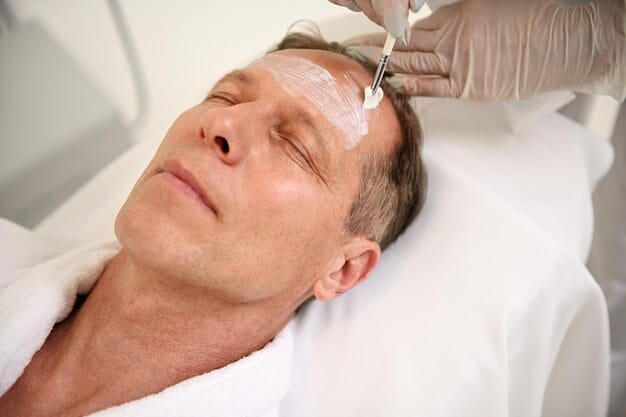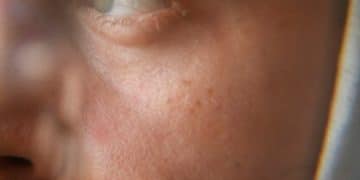Acne Scar Solutions for Men: Peels vs. Microdermabrasion

Acne scars can be a persistent concern for men, with chemical peels and microdermabrasion emerging as two prominent solutions, each offering distinct mechanisms and effectiveness in improving skin texture and tone for a smoother complexion.
Navigating the world of aesthetic treatments can feel overwhelming, especially when seeking effective solutions for persistent skin concerns. For many men, the aftermath of acne leaves behind a tapestry of scars, ranging from subtle discolouration to deep indentations. Understanding the optimal approach to diminish these marks is crucial for achieving clearer, more confident skin. This article delves into Acne Scar Solutions for Men: Comparing Chemical Peels and Microdermabrasion – What Works Best?, offering a comprehensive look at two of the most popular and effective treatments.
Understanding Acne Scars and Their Impact on Men
Acne scars are a stubborn reminder of past inflammatory acne, leaving behind textural changes on the skin. For men, these scars can be particularly bothersome, affecting self-esteem and confidence in professional and personal settings. Unlike temporary breakouts, scars are often permanent without intervention.
The type of acne scar dictates the most effective treatment. Atrophic scars, characterized by depressions in the skin, are common and include ice pick, boxcar, and rolling scars. Hypertrophic scars, less common, are raised and thickened areas. Understanding these distinctions is the first step toward effective treatment planning.
Types of Atrophic Acne Scars
Atrophic scars result from the destruction of collagen during the healing process of inflammatory acne. Each type presents differently:
- Ice Pick Scars: Narrow, deep, V-shaped indentations that extend into the dermis. They resemble a small hole made by an ice pick.
- Boxcar Scars: Broad, oval, or rectangular depressions with sharply defined vertical edges. They are wider than ice pick scars and vary in depth.
- Rolling Scars: Broad depressions with a gently sloping, rolling appearance. They are caused by damage to the underlying tissues, which creates a wavy texture on the skin’s surface.
Identifying the scar type is critical because different treatments target specific scar morphologies more effectively. For instance, deeper scars like ice picks often require more aggressive treatments, while rolling scars may respond better to procedures that stimulate collagen production over a broader area.
The Psychological and Social Impact
Beyond the physical appearance, acne scars can have significant psychological and social repercussions for men. They can lead to self-consciousness, anxiety, and even depression. In a society that often equates clear skin with health and attractiveness, visible scarring can influence perceptions of self-worth and social interaction.
Studies indicate that men, like women, often experience distress due to skin imperfections. Addressing acne scars is not merely about aesthetics; it’s about restoring confidence and improving overall quality of life. This drives the search for effective, reliable solutions.
Ultimately, a clear understanding of acne scar types and their potential impact empowers men to seek appropriate professional help. The journey to smoother skin begins with information, paving the way for targeted and successful interventions.
Chemical Peels: An In-Depth Look for Scar Reduction
Chemical peels involve applying a chemical solution to the skin, which exfoliates the outer layers, revealing smoother, less scarred skin beneath. This process encourages natural peeling and subsequent epidermal regeneration, alongside stimulating collagen production, which helps to plump up depressed scars.
For men seeking to reduce acne scars, chemical peels offer a versatile option, with different strengths tailored to various scar types and skin sensitivities. The selection of the right peel strength is paramount to optimize results and minimize adverse effects. This procedure is typically performed in a dermatologist’s office or a medical spa.

Types of Chemical Peels
Chemical peels are categorized by their depth of penetration, directly influencing their intensity and the recovery period:
- Light Peels (Superficial): These use mild acids like alpha-hydroxy acids (AHAs) or beta-hydroxy acids (BHAs). They primarily exfoliate the outermost layer of the skin (epidermis). Ideal for mild discolouration, improving skin texture, and very shallow scars. Multiple sessions are often required.
- Medium Peels: Often involve trichloroacetic acid (TCA). These penetrate deeper, reaching the outer and middle layers of the skin (epidermis and superficial dermis). Effective for more pronounced scars, fine lines, and moderate discolouration. Recovery is longer, with noticeable peeling for several days.
- Deep Peels: Typically use phenol and penetrate deeply into the middle layer of the skin. These are reserved for severe scarring, deep wrinkles, and significant sun damage. They offer dramatic results but require significant downtime and carry higher risks. Deep peels are rarely performed for acne scars alone due to their intensity.
The choice of peel depends on the depth and type of scars, as well as the patient’s skin type and tolerance for downtime. Consulting with a qualified practitioner is essential to determine the most appropriate peel for individual needs.
The Chemical Peel Process and Recovery
The process of a chemical peel begins with a thorough cleansing of the skin. The chemical solution is then applied evenly. Patients might experience a stinging or burning sensation, which subsides as the peel is neutralized or rinsed off. Post-peel, the skin typically appears red and may swell slightly.
Recovery varies significantly with peel depth. Light peels may only cause mild flaking, resembling a sunburn, lasting a few days. Medium peels result in more noticeable peeling and redness for up to a week. Deep peels necessitate an extended recovery period, often weeks, with significant redness, swelling, and crusting. During recovery, strict sun protection and gentle skincare are crucial to prevent complications and ensure optimal healing.
While chemical peels can dramatically improve the appearance of acne scars by promoting collagen remodeling and shedding damaged skin cells, they are not without risks, especially for darker skin tones, where hyperpigmentation can be a concern. Proper patient selection and post-treatment care are key to successful outcomes.
Microdermabrasion: A Gentle Approach to Skin Resurfacing
Microdermabrasion is a non-invasive cosmetic procedure that involves exfoliating the outermost layer of the skin using fine crystals or a diamond-tipped wand. Unlike chemical peels, it’s a mechanical exfoliation that gently buffs away dead skin cells, revealing a fresher, smoother complexion underneath. This process helps to improve skin texture, lighten superficial scars, and even out skin tone.
For men with superficial acne scars or those seeking to improve overall skin appearance with minimal downtime, microdermabrasion can be an attractive option. It is particularly effective for treating post-inflammatory hyperpigmentation (dark spots left after acne) and very shallow scars.
How Microdermabrasion Works
There are two primary methods of microdermabrasion:
- Crystal Microdermabrasion: A device sprays fine crystals (such as aluminum oxide or sodium bicarbonate) onto the skin, simultaneously vacuuming them up along with dead skin cells. This dual action exfoliates the skin surface and removes debris.
- Diamond-Tip Microdermabrasion: A wand with a diamond-encrusted tip is used to abrade the skin surface. The dead skin cells are then suctioned away. This method is often preferred for more sensitive areas, such as around the eyes, due to the absence of loose crystal particles.
Both methods work by creating a controlled injury to the skin’s superficial layer, prompting the body to repair the treated area by producing new skin cells and stimulating collagen production. While the effects on collagen are less dramatic than with deeper peels or laser treatments, consistent microdermabrasion sessions can lead to noticeable improvements over time.
The Microdermabrasion Process and Recovery
A microdermabrasion session typically begins with cleansing the skin. The aesthetician then moves the handheld device over the skin, applying gentle suction and exfoliation. The procedure is generally painless, with most patients reporting a sensation akin to a light sandpaper rub or rough cat lick. A session usually lasts between 30 minutes to an hour.
One of the key advantages of microdermabrasion is its minimal downtime. Immediately after the procedure, the skin may appear slightly pink or feel a bit sensitive, similar to a mild sunburn. This usually subsides within a few hours to a day. Patients can typically resume their normal activities immediately after treatment.
For optimal results, a series of microdermabrasion sessions is usually recommended, typically spaced 1 to 4 weeks apart, depending on the individual’s skin type and concerns. Maintenance sessions may also be advised to sustain the improvements. This gentle, progressive approach makes microdermabrasion a popular choice for those looking for gradual improvements with little interruption to their daily lives.
Comparing Chemical Peels and Microdermabrasion for Men’s Acne Scars
When selecting a treatment for acne scars, men often weigh different factors such as efficacy, downtime, cost, and suitability for their specific scar type. Both chemical peels and microdermabrasion are viable options, but they differ significantly in their approach and the depth of their effects. Understanding these distinctions is key to making an informed decision.
Efficacy and Best Use Cases
Chemical Peels: These are generally more aggressive and penetrate deeper into the skin. As such, they are more effective for a wider range of acne scars, including moderate to severe textural irregularities like boxcar and some rolling scars. They can also significantly improve discolouration (hyperpigmentation and erythema) and overall skin texture by promoting substantial collagen remodelling. Medium-depth peels, in particular, offer noticeable improvements in scar depth and appearance.
Microdermabrasion: This method is significantly gentler and primarily targets the outermost layer of the skin. It is best suited for superficial concerns, such as mild discolouration, very shallow scars, and improving overall skin radiance and smoothness. It is less effective for deeper, atrophic scars but can be an excellent choice for maintaining skin health and refining texture after more intensive treatments.
Downtime and Recovery
Chemical Peels: The downtime varies dramatically with the peel’s strength. Light peels typically involve minor flaking for a few days. Medium-depth peels can necessitate 5-7 days of noticeable redness, peeling, and sensitivity. Deep peels require weeks of intensive recovery, a significant consideration for men with busy schedules or public-facing roles.
Microdermabrasion: This procedure boasts minimal to no downtime. Patients can usually return to their normal activities immediately after a session. Mild redness might be present for a few hours. This makes microdermabrasion ideal for those who cannot afford extended recovery periods.
Cost and Number of Sessions
Chemical Peels: The cost per session for chemical peels can vary widely based on the type and depth of the peel, as well as the practitioner’s expertise and location. Medium peels, for example, are more expensive per session than light peels. While results might be achieved in fewer sessions than microdermabrasion for significant scar improvement, the total cost for a series of peels can still be substantial.
Microdermabrasion: Generally, microdermabrasion sessions are less expensive individually than chemical peels. However, achieving desired results, especially for persistent concerns, often requires a series of multiple sessions (e.g., 5-12 sessions initially, followed by monthly maintenance). This cumulative cost can add up, but the lower per-session price makes it more accessible for some individuals.
In essence, choosing between chemical peels and microdermabrasion depends on the severity of the acne scars, the patient’s tolerance for downtime, their budget, and their ultimate aesthetic goals. Often, a combination approach or a phased treatment plan might be recommended by a dermatologist for optimal results.

Pre-Treatment Consultation and Post-Care Essentials
Regardless of whether chemical peels or microdermabrasion are chosen, a thorough pre-treatment consultation and meticulous post-care are crucial for optimizing results and minimizing potential complications for men. These steps ensure that the treatment is both safe and effective for the individual’s skin type and concerns.
The Importance of a Consultation
A comprehensive consultation with a qualified dermatologist or aesthetic practitioner is non-negotiable. During this session, the practitioner will:
- Assess Skin Type and Scarring: Determine the client’s skin type (e.g., Fitzpatrick scale), identify the types and severity of acne scars, and evaluate any underlying skin conditions. This assessment is vital for selecting the most appropriate treatment.
- Discuss Medical History: Review the client’s medical history, including past skin conditions, use of medications (especially retinoids or isotretinoin), allergies, and any history of keloid scarring. Certain conditions or medications can contraindicate specific treatments.
- Set Realistic Expectations: Explain what results can realistically be achieved, the number of sessions likely required, and the expected downtime. Managing expectations is crucial for patient satisfaction.
- Outline Potential Risks: Discuss potential side effects and risks associated with the chosen procedure, such as redness, swelling, peeling, infection, or hyper-pigmentation. This ensures the client provides informed consent.
This initial consultation is an opportunity for the client to ask questions and clarify any concerns, ensuring they feel comfortable and confident with the proposed treatment plan. It forms the foundation of a successful treatment journey.
Essential Post-Treatment Care for Men
Post-treatment care is as important as the procedure itself in achieving desired outcomes and preventing complications. Adherence to post-care instructions greatly influences healing and skin recovery:
- Sun Protection: This is arguably the most critical aspect of post-treatment care. Skin will be highly sensitive to UV radiation. Daily application of a broad-spectrum sunscreen with SPF 30 or higher is mandatory, even on cloudy days. Hats and avoiding peak sun hours are also recommended.
- Gentle Cleansing and Moisturizing: Use mild, non-abrasive cleansers and rich, hydrating moisturizers recommended by the practitioner. Avoid harsh exfoliants, retinoids, or active ingredients like vitamin C for a specified period, as they can irritate sensitive skin.
- Avoid Picking or Peeling: Allow the skin to shed naturally. Picking at peeling skin can lead to scarring or discolouration and increases the risk of infection.
- Stay Hydrated: Drinking plenty of water supports overall skin health and aids in the healing process from within.
Following these guidelines diligently will help ensure a smooth recovery and optimize the long-term benefits of the chosen acne scar treatment. Communication with the practitioner post-treatment concerning any unexpected reactions is also vital.
Advanced and Emerging Treatments Beyond Peels and Microdermabrasion
While chemical peels and microdermabrasion are effective for many, the field of dermatological aesthetics is constantly evolving. For men with more stubborn or complex acne scars, or those seeking alternative approaches, a range of advanced and emerging treatments provides additional solutions. These procedures often target deeper skin layers and can offer more dramatic results for specific scar types.
Laser Resurfacing Treatments
Laser treatments are among the most powerful tools for acne scar revision. They work by using focused light energy to remove thin layers of skin or to stimulate collagen production in the dermis without ablating the surface. There are two main types:
- Ablative Lasers (e.g., CO2, Erbium YAG): These vaporize the top layers of damaged skin, leading to significant skin resurfacing and collagen remodeling. They are highly effective for deep boxcar and rolling scars but involve considerable downtime and risk of side effects like prolonged redness and discolouration.
- Non-Ablative Lasers (e.g., Fraxel Restore, Pulsed Dye Laser): These bypass the skin’s surface, heating the underlying tissue to stimulate collagen production without causing visible wounds. They have less downtime but are less aggressive and require multiple sessions for noticeable improvement, often best for subtle scars and redness (post-inflammatory erythema).
Fractional lasers, both ablative and non-ablative, treat only a fraction of the skin at a time, creating microscopic channels. This speeds up recovery significantly while still yielding impressive results for various scar types, making them a popular choice for deeper atrophic scars.
Microneedling and PRP Therapy
Microneedling, also known as collagen induction therapy, uses a device with fine needles to create controlled micro-injuries in the skin. These micro-injuries trigger the body’s natural healing response, leading to increased collagen and elastin production. It is particularly effective for improving the appearance of rolling and boxcar scars, as well as overall skin texture.
Microneedling can be enhanced by combining it with Platelet-Rich Plasma (PRP) therapy. PRP is derived from the patient’s own blood and contains growth factors that further promote healing and collagen synthesis when applied to the skin during or immediately after microneedling. This combination is often referred to as a “vampire facial” and can accelerate scar improvement and skin rejuvenation.
Dermal Fillers and Subcision
For depressed (atrophic) scars, especially rolling scars, dermal fillers can be an excellent temporary solution. Injectable substances, such as hyaluronic acid, are used to plump up the depressed areas, making them level with the surrounding skin. Results are immediate but typically last from several months to a year, requiring repeat treatments.
Subcision is a minor surgical procedure used to treat deeply rolling or tethered scars. A needle is inserted under the skin to break up the fibrous bands that pull the skin downwards, allowing the treated area to elevate and new collagen to form. It is often combined with other treatments like lasers or fillers for enhanced outcomes.
The landscape of acne scar treatment is broad and continually evolving. A personalized treatment plan, combining different modalities, often yields the most satisfactory results, particularly for men with a variety of scar types. Consulting with an experienced dermatologist is crucial to navigate these advanced options and determine the optimal path for individual needs.
Making the Right Choice: Tailoring Treatments for Men
Selecting the most effective acne scar solution for men is not a one-size-fits-all endeavor. The ideal treatment plan is carefully tailored, considering individual factors such as scar type, skin complexion, lifestyle, pain tolerance, and budget. A personalized approach, often involving a combination of therapies, typically yields the most satisfying outcomes.
Factors Influencing Treatment Decisions
Several key factors guide the decision-making process for men choosing between chemical peels, microdermabrasion, or more advanced treatments:
- Scar Type and Severity: As previously discussed, different scars respond to different treatments. Superficial discolouration and very shallow scars may benefit from microdermabrasion or light chemical peels. Deeper atrophic scars often require more aggressive interventions like medium chemical peels, fractional lasers, or subcision.
- Skin Type and Tone: Men with darker skin tones (Fitzpatrick types IV-VI) need to be particularly cautious with treatments that carry a risk of post-inflammatory hyperpigmentation, such as aggressive chemical peels or ablative lasers. Gentle approaches or specific laser wavelengths are often preferred to minimize this risk.
- Downtime Tolerance: A man’s professional and social commitments significantly influence the choice of treatment. Those who cannot afford significant downtime might opt for microdermabrasion or light peels, even if it means more sessions. Those with flexibility may consider more intensive treatments for faster, more dramatic results.
- Budget: The cost of treatments varies widely. A single deep peel might be more expensive than several microdermabrasion sessions, but the total number of sessions required and long-term maintenance costs also need to be factored in.
An honest discussion with a dermatologist about
these factors is essential to devise a realistic and effective treatment strategy that aligns with the individual’s goals and circumstances.
The Role of Maintenance and Skincare
Achieving clear, smooth skin is not solely about in-office procedures; a consistent at-home skincare routine plays a vital supporting role. For men, this means:
- Daily Sun Protection: Absolutely critical to prevent new discolouration and protect treated skin.
- Gentle Cleansing: Using a mild cleanser to remove impurities without stripping the skin’s natural oils.
- Hydration: Applying a non-comedogenic moisturizer tailored to one’s skin type.
- Exfoliation (when appropriate): Incorporating mild exfoliants (like salicylic acid washes) if recommended by a dermatologist, to prevent new breakouts and maintain skin clarity.
Maintenance sessions of treatments like microdermabrasion or light peels may be recommended to sustain improvements and keep the skin looking its best. The journey to scar-free skin is often a marathon, not a sprint, requiring patience, consistency, and a partnership with a qualified skincare professional.
By carefully considering all these aspects, men can confidently pursue the most suitable and effective solutions for their acne scars, leading to improved skin health and boosted self-confidence.
| Key Treatment Aspect | Brief Description |
|---|---|
| 🎯 Effectiveness | Peels for deeper scars, Microdermabrasion for superficial. |
| ⏰ Downtime | Peels: Variable (days to weeks), Microdermabrasion: Minimal to none. |
| 💰 Cost | Peels: Higher per session; Microdermabrasion: Lower per session, more sessions. |
| ⚕️ Safety Profile | Professional consultation crucial; risks vary by invasiveness. |
Frequently Asked Questions About Acne Scar Treatments for Men
Chemical peels can range from a mild tingling for superficial peels to a stinging or burning sensation for medium-depth peels, often managed with cooling. Microdermabrasion is generally painless, described as a gentle scratching or vibrating sensation on the skin, with minimal discomfort during or after the procedure.
For chemical peels, 3-6 sessions for light peels or 1-3 for medium peels might be needed. Microdermabrasion usually requires 5-10 sessions, spaced 1-4 weeks apart, to achieve significant improvements in skin texture and scar appearance. Results vary based on scar severity and individual skin response.
While effective for many, chemical peels and microdermabrasion are best for superficial to moderate acne scars and discolouration. Deeper scars like ice pick or severe boxcar scars may only see partial improvement and might require more aggressive treatments, such as laser resurfacing, subcision, or dermal fillers, for optimal results.
Yes, pre-treatment preparation is common. For chemical peels, men might be advised to stop using retinoids or other strong exfoliants a week prior. For both treatments, avoiding sun exposure and tanning is crucial. A clean-shaven face might be required on the day of treatment for better product application or device gliding.
Common side effects include temporary redness, swelling, and flaking. More intense treatments like medium peels can cause prolonged redness, crusting, or temporary hyper-pigmentation, especially in darker skin tones. Rare complications include infection or permanent scarring, emphasizing the importance of choosing a qualified practitioner and following post-care instructions thoroughly.
Conclusion: Paving the Way to Clearer Skin
For men seeking to diminish the visible remnants of acne, both chemical peels and microdermabrasion offer compelling pathways to clearer, smoother skin. Each treatment brings its unique advantages, addressing different types and severities of scars with varying degrees of invasiveness and downtime. Chemical peels, especially medium-depth ones, excel in tackling more significant textural irregularities and discolouration, albeit with a longer recovery period. Microdermabrasion, on the other hand, provides a gentler, low-downtime option ideal for refining skin texture and addressing superficial concerns. The ultimate decision hinges on a personalized assessment, guided by a qualified dermatologist who can evaluate scar type, skin complexion, and individual lifestyle, potentially recommending a bespoke combination of treatments. With dedicated adherence to professional advice and consistent post-care, men can confidently embark on a journey that leads not just to improved skin, but also to a significant boost in self-esteem and confidence.





